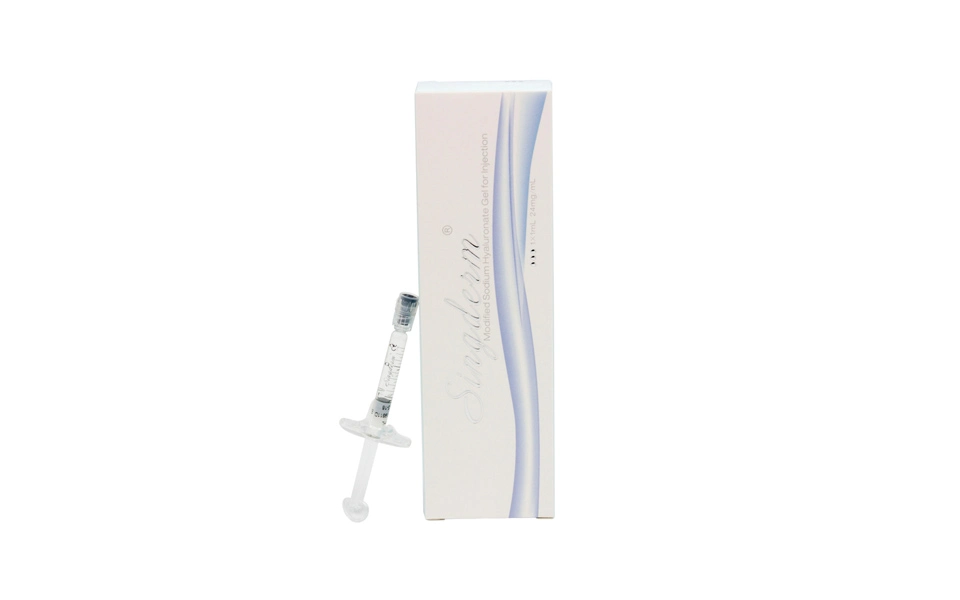In recent years, injectable fillers have become an indispensable part of aesthetic medicine. The market is now flooded with a variety of fillers. The rapid development of injectable fillers is bringing them closer to the “perfect” product: long-lasting but not permanent, highly tolerable, providing refined and natural aesthetic results, and reversible in case of adverse outcomes. Currently, fillers on the market are further divided into biodegradable and non-biodegradable categories. The choice of product depends on the preferred injection technique, expected results, and the injection site.
These are non-permanent agents that maintain their effects for a relatively long time (sometimes up to 12 months) but are eventually metabolized by the body. Biodegradable fillers stimulate collagen regeneration to achieve lasting aesthetic improvements, with a low risk of adverse outcomes. Due to their non-permanent and easily correctable nature, these agents are favored by both doctors and patients.
The use of autologous soft tissue fillers began as early as 1983 with the use of autologous fat to repair facial scars. Today, fat grafting is an adjunct to platelet-rich plasma and stem cell breast augmentation. Many factors affect the optimal outcome of fat grafting, including the method and type of fat harvesting, the injector’s experience, and the unpredictability of the results, which can be transient. The duration of the effect can range from a few months to several years. The side effects of fat grafting are more pronounced: fat transfer can prolong swelling and bruising and carries risks of infection and necrosis. There have been reports of blindness and stroke when fat is injected into the glabella and nasolabial folds.

Due to its natural appearance, ease of use, reversibility, and low incidence of adverse reactions, hyaluronic acid has become a classic facial filler widely used worldwide. Hyaluronic acid is rich in glycosaminoglycans, a type of high molecular weight polymer. Commercially, cross-linking technology is used to extend the duration of these products. When injected into the skin or subdermis, hyaluronic acid can bind with water molecules to increase skin volume, with effects lasting 6-12 months. Recent studies have also shown that hyaluronic acid can lead to collagen regeneration. The hyaluronic acid in the body is eventually degraded and cleared by the liver.
Most hyaluronic acid products are used to treat moderate to severe facial wrinkles and are also applied to other facial areas to restore skin volume and reduce wrinkles. Customers can choose the ideal injectable product based on their needs, but areas like the mouth, which are frequently moved, may not achieve the most satisfactory results, as repeated movements can reduce the lifespan of the filler. Serious adverse reactions to hyaluronic acid HA fillers are rare. Common side effects include temporary mild pain, swelling, and rash due to technical reasons. If the injection results are unsatisfactory within 24-48 hours, hyaluronidase can be used to dissolve and remove the filler. This feature makes hyaluronic acid injectable products more favored by patients compared to other products.
Calcium hydroxylapatite (CaHA) consists of bone-like spherical particles suspended in a sodium carboxymethylcellulose gel, which can create a new gel matrix at the injection site, lasting for 15 months or longer, and is eventually metabolized by the body. CaHA is not suitable for the lips, tear troughs, glabella, or superficial injections.
Poly-L-lactic acid (PLLA) is a biodegradable product synthesized from α-hydroxy acids. When injected into the skin, it induces a subclinical inflammatory response and fibroplasia, ultimately leading to progressive tissue volume increase. This product is also eventually metabolized over time.
Most adverse reactions caused by poly-L-lactic acid are common, small palpable nodules related to poor product structure or injection site. In most cases, these palpable but invisible nodules do not require treatment. However, non-granulomatous visible nodules need to be treated with hyaluronic acid until the nodules are absorbed. This product should not be used in dynamic areas such as the lips or around the eyes.
Platelet-rich fibrin matrix is derived from the centrifugation of whole blood and is another FDA-approved safe and rapid autologous product used in plastic surgery. This product can be used to fill scars and reduce wrinkles but is accompanied by transient micro-bruising or swelling. Its safety and efficacy require further research.
Permanent fillers have good efficacy and long-lasting effects but carry greater risks, requiring highly skilled operators. They are also more prone to complications, which are more difficult to manage.
Bellafill is the third-generation polymethylmethacrylate (PMMA) filler, approved by the FDA in 2006 and 2015 for use in nasolabial folds and moderate to severe acne scar repair. Achieving satisfactory results usually requires multiple injections, and the product’s effects are not immediate, taking months or even a year to meet aesthetic requirements. PMMA is mainly used for patients with high therapeutic demands for facial wasting, cheek hollows, nasal irregularities, zygomatic filling, and deep lines and wrinkles such as nasolabial folds, forehead wrinkles, and acne scars. PMMA should not be used for the lips. A skin allergy test is required before treatment.
When using PMMA, special attention should be paid to the injection site, and the method should be conservative, with sufficient intervals between injections. Overall, the third-generation PMMA products have a significantly lower incidence of adverse reactions compared to the first two generations. The main types of adverse reactions include nodules, beading, scar formation, and delayed granulomas.
Liquid injectable silicone (LIS) was initially used in ophthalmic surgery. Its use in cosmetic surgery is controversial due to the risk of long-term complications. LIS injections in the face stimulate collagen regeneration, providing immediate and long-lasting effects. This product can also be used to treat HIV-related facial fat atrophy, lip augmentation, facial contouring, acne scar repair, and age-related wrinkles.
 Call us on:
Call us on:  Email Us:
Email Us:  No. 125(E), 10th Street, Hangzhou Qiantang Area, Zhejiang, China
No. 125(E), 10th Street, Hangzhou Qiantang Area, Zhejiang, China